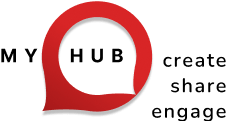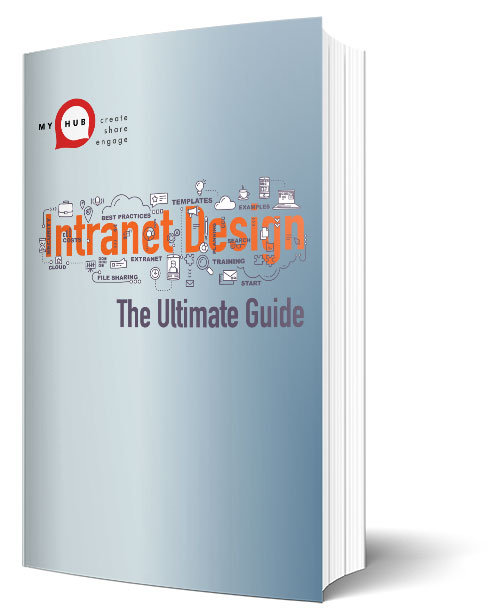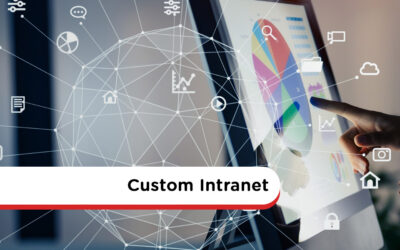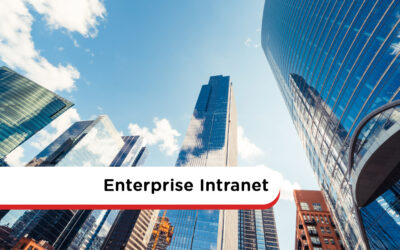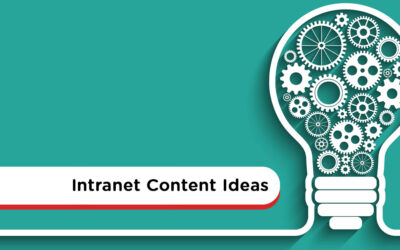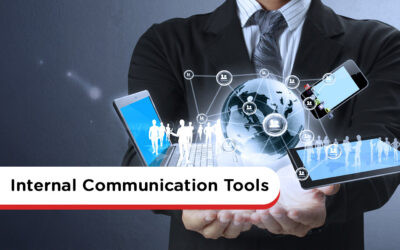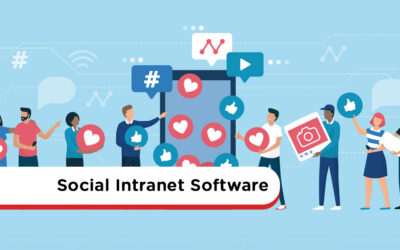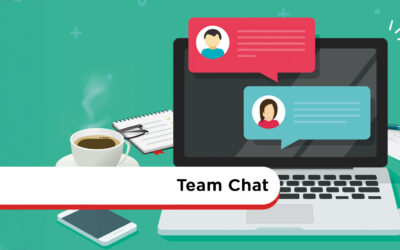The Intranet Design Guide
Not sure where to get started in designing your intranet?
Check out our easy step-by-step guide below.
Let us guide you through the process.

Intranet Design Made Simple
Deciding to go ahead with an intranet was the easy part, right? After all, whether it’s improved communications, more streamlined processes, or easier access to information, the intranet ticks all the boxes.
However, designing your intranet can be a daunting task.
There are many decisions to be made around the type of intranet, hosting options, organization, structure, plus content, and design. With so much to think about, it can be tough to get started.
And if technology isn’t really your thing, it can be even harder to kick-start your intranet. That’s where this intranet design guide comes into play.
So, if widget, cache, and malware sound like another language, then this guide is for you! Written in simple-to-understand and jargon-free terms, the design guide is non-technical. And where technical language is unavoidable, we clearly define what we mean.
This guide will show you that designing an intranet is a simple task. In fact, it’s so easy, you won’t need IT backup or a college degree in computers!
Click here to download this guide in PDF format
Step-By-Step Intranet Design Support
The guide is a comprehensive resource, covering everything you need to know about intranets. We provide helpful insights at every stage, from different intranet types and hosting options to security and training.
And we also look at all the latest intranet design best practices. This resource includes lots of practical examples and visuals that will excite and inspire you.
What’s Included In This Intranet Design Guide
Who Should Read This Guide
The design guide is an essential resource for anyone planning to implement a new intranet. It’s also required reading if you are looking to revitalize, revamp, or refresh an existing intranet.
Perhaps you are in the market for an intranet provider to help you realize your vision. The design guide can help you make a winning selection.
Written for the non-technical person, this resource will also support HR or Marketing staff tasked with implementing an intranet.
Why Intranet Design Is So Important
Before we move on, it’s essential to understand why intranet design is so important.
Your intranet’s overall look and feel has the power to grab users’ attention and draw them in. It can spark creativity and foster collaboration. It can connect employees and turn the everyday task into something engaging and fun.
However, the stakes are high. A poorly designed intranet will have the opposite effect. A confusing, overloaded, and ugly intranet will see staff switch off. It’s a wasted opportunity as well as investment.
With so much to lose, getting your intranet design right has to be a priority.
No Two Intranets Are Alike
When it comes to design, there is no one-size-fits-all intranet solution. Sure, there will be similarities. It could be layout, functionality, or scope. However, every organization is different, and so too is their intranet.
Furthermore, staff members will use the intranet differently depending on their job roles and team functions.
Employees use the intranet mainly to source information or collaborate with colleagues. Managers, however, use the intranet to engage workers with targeted communications.
Your intranet design needs to satisfy all the varying needs of employees.
And it also needs to meet the challenges of the modern digital workplace.
The global Covid-19 pandemic has fast-tracked the shift towards remote working. Companies have to pivot and rethink how they engage with their workforce in today’s rapidly changing environment.
And they need to ensure employees have the tools available to remain productive even when working from home.
A mobile intranet is a minimum requirement. In fact, it’s not so much a requirement as an expectation. Whether staff are on the go or working from home, they expect to continue working.
Versatile and flexible, the intranet is capable of meeting these competing demands. And your intranet design should make this vision a reality.
Intranet Templates Make Design Easy
And if you are pushed for time, then intranet design templates could be the perfect solution. This guide takes you through all you need to know.
In short, intranet templates come with in-built coding plus a basic design and graphics. The setup wizard makes it quick and easy to implement your customized intranet. Upload your logo, branding, and corporate colors to really put your company stamp on the intranet. And the good news is the intranet provider has already extensively tested the functionality. And that’s one less major headache for you to worry about.
Therefore, design templates are a popular choice if you need to get your intranet up and running quickly.
Let Us Guide You
Use this guide to make your intranet deployment a smoother and quicker process.
Essential reading for those starting to deploy an intranet, this resource will also help businesses looking to revamp an existing intranet.
Either way, we understand the challenges that are involved. And you get the benefit of our experience as we guide you through the process from beginning to end.
So, let’s get started.
Intranet Design Infographic
If you would like an overview of our intranet design guide, we have created a PDF infographic file summarizing the main points available here.
Further Reading
This further reading list will be an invaluable resource as it takes you through everything you need to know. We give you the benefit of our considerable experience in developing intranets and provide simple, easy-to-follow explanations, insights and advice.
Use this list to explore the latest intranet design best practice principles. Find out how pre-built intranet templates could well be the solution every time-pressed business owner is looking for. Discover how to ensure your intranet design is mobile friendly and optimized for use on smartphones and tablets. And learn about how to make your intranet interactive and fun so that users readily engage with the platform making for a more efficient and effective workplace.
These are just some of the insights available in this category so why not have a browse or use the search functionality to explore more about intranet design. With our comprehensive knowledge bank, you’ll soon discover that designing an intranet isn’t the mammoth task that perhaps you first thought it was.
Google Intranet: Unleash The Power Of Google Workspace In Your Intranet
Google Workspace has evolved into a staple for businesses of all sizes, providing cloud-based tools like Gmail, Google Docs, Sheets, Slides, Calendar, and Google Drive. These tools offer real-time collaboration, easy sharing, and ubiquitous access. When combined with a modern intranet, Google Workspace becomes even more powerful—bringing together document editing, communication, workflows, and collaboration in a unified platform.
MyHub’s Google-intranet model allows embedding Google documents (Docs, Sheets, etc.) directly within the intranet, meaning users don’t need to toggle between multiple apps. Permissions and document updates are managed in real time, ensuring everyone is always working from the latest version. This integration also supports single sign-on and unified access—reducing login fatigue and improving usability.
The benefits are broad: more efficient internal communication (news, forms, alerts), increased employee engagement through simplified workflows, better knowledge management by centralizing files and context, and cost savings from reduced tool overlap. MyHub also highlights that using Google Workspace together with their intranet increases scalability, reliability (cloud backups), automatic updates, and flexibility for hybrid-or remote work.
Custom Intranet: The 5 Best Intranet Builder For 2025
A custom intranet allows organizations to go beyond basic out-of-box solutions by tailoring features, branding, layout, and integrations to their own needs. Unlike generic intranets, custom ones support specialized workflows, employee engagement, and knowledge management in ways that align closely with the organization’s culture and goals.
The article lists 5 top intranet builder solutions for 2025—platforms that offer drag-and-drop design, strong theming and branding options, integrations with tools like Microsoft 365 or Google Workspace, mobile support, news feeds, collaboration tools, and search functionality. These builders vary in price, flexibility, and level of vendor support.
It also provides guidance for choosing the right custom intranet: assessing business needs, listing “must-have” versus “nice-to-have” features, evaluating usability, vendor reputation, scalability, cost models, and customization ability. The goal is to pick a platform that balances flexibility with ease of use.
Good Organizational Skills: 10 Strong Key Skills You Need
Strong organizational skills are essential in a fast-moving work environment where tasks, meetings, and digital clutter can easily overwhelm. The article highlights 10 key improvements—including keeping a clean, distraction-free workspace, using technology and digital tools, planning schedules, and adopting time-blocking methods—to help you stay focused and efficient.
It emphasizes using tools like digital calendars, reminders, to-do lists, and project management software (or intranet workflows) to manage tasks across different platforms. Prioritizing what needs to be done each day or week, and reorganizing as needed, helps maintain control and reduces stress over missed deadlines or overlapping commitments.
Beyond tools and systems, the post also points out the importance of reward, rest, and balance. Small celebrations of achievements, working in balanced blocks, minimizing distractions, and ensuring downtime are all part of sustaining and growing strong organizational skills over time.
SaaS Intranet Platform for Streamlined Communication And Collaboration
A SaaS intranet is a cloud-based intranet platform provided over the internet rather than hosted on-premises. It removes the burden of infrastructure setup, server maintenance, and software development for companies, letting them focus instead on using the intranet’s capabilities—communication, knowledge sharing, and collaboration—from day one.
These platforms offer numerous benefits including rapid deployment—thanks to out-of-the-box templates and drag-and-drop setup—scalability that grows with the business, robust security managed by the provider, and automatic updates that ensure the intranet stays current without manual intervention. Access is global, whether via desktop or mobile, which makes SaaS intranets especially valuable for remote or distributed teams.
Key features to look for in a SaaS intranet include intuitive ease of use, strong integration with existing tools (CRMs, Microsoft 365, Google Workspace, etc.), mobile accessibility, advanced search, analytics for tracking engagement, and collaboration tools such as instant messaging, news feeds, and employee profiles. To pick the right solution, organizations should assess their needs, security requirements, pricing models, and vendor support.
Enterprise Intranet Software: Use Cases, Examples, Solutions
An enterprise intranet is more than just an internal website—it’s a full digital workplace platform designed for large or distributed organizations. Modern enterprise intranets support internal communication, collaboration, knowledge sharing, and employee engagement from a central, secured location. With remote work now standard and many employees operating outside traditional offices, mobile access and ease of use are critical.
To deliver value, there are several must-have features: communication tools like newsfeeds and instant messaging; social features such as employee profiles, @mentions, and activity walls; collaboration spaces for projects; real-time analytics to track usage and engagement; unified, advanced search; seamless integrations with tools like Microsoft 365 or Google Workspace; and strong security protocols.
The platform should serve both office-based and desk-less workers, ensuring everyone can access relevant content wherever they are.
MyHub includes several real-world case studies showing enterprise intranets in action. For example, Idaho Lottery uses it so field and remote staff can access reports, change requests, and social features easily via mobile. Best Western Hotels’ Scandinavian arm streamlined collaboration across many hotel sites with centralized document access, mobile-friendly interfaces, and better internal communication. These examples illustrate how enterprise intranets aren’t just about having tools—they’re about making them usable, accessible, and embedded in daily work.
Employee Intranet: 42 Hot Reasons Why Every Business Needs One
An employee intranet is a secure, private network for a company’s employees, acting as a central hub for internal communication, collaboration, and access to tools and resources. MyHub explains that it can be used for everyday tasks like expense claims and meeting room booking, as well as more complex needs like cross-team collaboration, knowledge sharing, and streamlined operations.
The article contrasts building an intranet yourself (on WordPress, SharePoint, etc.) with using a cloud-hosted intranet provider. DIY options can offer customization but often require extra plug-ins, technical effort, and long setup time. In contrast, cloud intranet services use pre-built templates, are quicker to deploy, typically have fixed pricing, and need less technical overhead.
MyHub lists 42 reasons why a business needs an employee intranet. Some of the key advantages include enhancing internal communication, making leadership more accessible (e.g. through CEO blogs), facilitating feedback via surveys and quizzes, improving knowledge management, enabling mobile access so that remote, on-the-road, or deskless workers stay informed, automating workflows, improving discoverability via search, supporting onboarding and offboarding, boosting employee engagement, and reinforcing company culture.
Essential Strategies for a Successful Banking Intranet
Banks and financial institutions have unique needs—strict regulatory oversight, high expectations for data security, and the demand for highly efficient internal operations. A finance or banking intranet offers a private, secure network designed to address exactly those challenges. It centralizes communication, improves collaboration across departments, and creates one source of truth for policies, documents, forms, workflows and internal news.
The benefits are wide-ranging. With a well-implemented intranet, financial teams can boost productivity by reducing time spent searching for documents, ensure compliance by controlling access and maintaining versioned policy documents, improve internal communication through company news feeds and recognition programs, and support knowledge sharing using searchable directories and blogs.
When planning a banking or finance intranet, several essential features and strategies stand out. Advanced security (SSL, multi-factor authentication, role-based permissions) is non-negotiable. Digital forms, customizable workflows, document management with version control, mobile-friendly access and real-time search functionality are also key parts of a successful platform. Finally, getting buy-in from employees, clear objectives, a carefully chosen platform, proper training, and alignment with compliance requirements are critical steps in the rollout process.
25 Intranet Content Ideas and Best Practices to Improve Your Intranet
Your intranet may have launched with excitement, but over time content can feel stale and starts to lose its pull. The post notes many organizations struggle with dwindling engagement, where employees say the intranet “doesn’t engage” like it used to. That signals a need for fresh ideas.
To revitalize your intranet, the article offers 25 content ideas designed to inject energy, relevance, and interaction. These span traditional updates like “Internal Communication” and “CEO News Blog,” visual content like video and graphics, people-focused posts including employee recognition or profile spotlights, remote team connections, gamification, onboarding hubs, health & wellbeing, and more. Each idea is meant to add value—make users feel seen, informed, and involved.
Finally, it wraps up with best practices to make content actually work: keep it relevant (don’t overload employees with noise), design it to be engaging (use visuals, interaction, employee-generated content), vary formats (mix text, video, polls, etc.), and plan ahead with a content calendar so there’s always something new. Also, ensure navigation & tagging make content easy to find, and routinely remove outdated or irrelevant material.
Finance Intranet: Benefits, Features, And User Examples
The financial industry faces unique challenges, including stringent regulatory requirements, data security concerns, and the need for efficient internal communication. A finance intranet serves as a secure, centralized platform that addresses these challenges by facilitating seamless collaboration, document management, and compliance tracking.
Key benefits of implementing a finance intranet include centralized information and document management, improved knowledge sharing, streamlined cross-departmental collaboration, enhanced internal communication, increased productivity, and better customer service. These advantages contribute to a more efficient and compliant financial institution.
Real-world examples demonstrate the effectiveness of finance intranets in various organizations. For instance, financial institutions have utilized intranet platforms to automate workflows, securely share documents, and facilitate communication across departments, leading to improved operational efficiency and customer satisfaction.
Disengaged Employees: How Deal With Disengaged Workers
Employee disengagement poses significant challenges to organizations, impacting productivity, morale, and overall performance. Disengaged employees often exhibit signs such as lack of enthusiasm, low energy, frequent tardiness, minimal effort, and avoidance of social interactions. These behaviors not only hinder individual performance but can also influence team dynamics negatively. Recognizing these signs early is crucial for timely intervention.
The causes of disengagement are multifaceted, ranging from poor alignment with the organization’s mission to lack of recognition and limited growth opportunities. Addressing these issues requires a comprehensive approach, including open communication, leadership development, and fostering a culture of appreciation. Implementing strategies that promote employee well-being and professional growth can significantly reduce disengagement levels.
Taking proactive measures to re-engage employees is essential. Strategies such as providing clear career development paths, offering regular feedback, and creating an inclusive work environment can reignite motivation and commitment. By investing in these areas, organizations can transform disengaged employees into active contributors, leading to improved performance and a more positive workplace culture.
Healthcare Intranet: Streamline Processes & Enhance Patient Care
Healthcare organizations face unique challenges when delivering patient care, often needing real-time access to protocols, workflows, and updates. A modern intranet serves as a centralized hub—offering a secure way to share policies, SOPs, workflows, and broadcast vital alerts to staff across facilities and mobile settings. Key features like two-factor authentication, privacy controls, and SSL encryption safeguard sensitive information in line with HIPAA requirements.
Beyond compliance, intranets simplify the daily lives of medical teams. Built to be user-friendly, visually engaging, and straightforward, these platforms sit on a strong foundation of no-code ease and custom integrations—whether for Microsoft 365, Google Workspace, or payroll systems. Designed for the fast-paced healthcare environment, they bring information directly to hands on the go via mobile apps.
Real-world use cases show how diverse healthcare settings benefit. For instance, aged care homes use intranets for social calendars, maintenance and care requests, digital SOP libraries, and family-facing extranet portals; Medical groups enable push-based workflow automations, blogs, video knowledge sharing, searchable contact directories, and shared on-call schedules; and multi-disciplinary clinics collaborate on practice docs via embedded tools, communicate instantly between sites, and publish recognition updates to keep morale high.
10 Must-Have Internal Communication Tools
Effective internal communication hinges on having the right mix of tools that foster clarity, connection, and engagement across diverse teams. The MyHub article presents the 10 most essential tools organizations should have in their communication toolkit—from central intranet platforms to mobile access and instant messaging. Each plays a role in bridging gaps and streamlining workflows today.
At the top of the list is the company intranet, a secure, central hub that links employees to information, resources, newsfeeds, directories, and collaborative tools. Complementary tools like mobile intranet apps ensure no one is disconnected—especially frontline or remote staff. Features such as update feeds, instant messaging, collaboration spaces, internal blogs/CEO messaging, knowledge management modules, feedback surveys, project tracking, and internal social networks round out a powerful agenda for engagement and productivity.
Together, these tools create a connected workplace where information flows seamlessly, feedback is honored, collaboration thrives, and every team member—regardless of location—has a voice. From actionable newsfeeds to two-way forums and social channels, modern internal communication goes deeper than broadcasting. It’s about building relationships, trust, and efficiency—all through purposeful tools.
Social Intranet Software – Social Media Networking For Employees
A social intranet transforms the traditional internal network into a vibrant collaboration hub. By incorporating features like instant messaging, activity walls, forums, and personalized employee profiles, it bridges the communication gap between remote, hybrid, and in-office teams—making interaction seamless and inclusive.
These platforms enable meaningful engagement through recognition tools, giving employees a voice at all levels—from top-down announcements to peer shoutouts and peer-to-peer thanks. The benefits extend to faster decision-making facilitated by real-time messaging (with 66% of users resolving queries quickly and 75% seeing reduced calls and emails), efficient knowledge sharing, and speedy onboarding via virtual channels.
Social intranets also strengthen company culture by letting employees share personal interests through rich user profiles—fostering connections even when teams are spread across locations. Their impact ranges from improved morale and reduced absenteeism to smoother onboarding and problem-solving, especially within distributed teams.
Sharing Ideas – How To Encourage Staff To Share Ideas
Encouraging employees to share ideas, knowledge, and insights is essential for nurturing innovation and improving business performance. Modern intranet platforms facilitate a smooth idea-sharing experience by being accessible to all staff—as well as to freelancers, contractors, and remote workers—at any time. These systems provide a structured environment where contributions thrive.
Successful idea-sharing involves more than just collecting suggestions—it requires the right tools and culture. Intranet-based systems stand out by making idea submission accessible, enabling transparent tracking, and allowing employees to monitor progress on their contributions. This fosters trust, keeps creativity flowing, and prevents the feeling of being ignored.
By formalizing idea-sharing processes—especially using intranet technology—organizations capture frontline insights more effectively, speed up evaluation and implementation, and maintain transparency throughout. This strengthens engagement, fuels collaboration, and helps transform spontaneous eureka moments into tangible improvements.
Team Chat – All You Need To Know About Team Instant Messaging
Team chat software brings workplace communication into the fast lane, blending messaging, file sharing, and group discussion into seamless workflows. With over three billion global users relying on platforms like Facebook Messenger and WhatsApp in their personal lives, businesses have quickly embraced tools like Slack, Microsoft Teams, and Google Chat to connect remote, hybrid, and on-site teams in real time. Unlike email, these tools enable instant responses, visibility of read status, and quick group collaboration—ideal for fast problem-solving and inclusive dialogue.
Core features of modern team chat platforms include real-time messaging with emojis and attachments, customizable notifications and themes, and powerful search capabilities that ensure past messages and files are always within reach. For organizations using intranet platforms like MyHub, integrated team chat takes collaboration up a notch—seamlessly combining messaging, channels, user status, and single sign-on access to create a fluid, productive communication experience.
The benefits are plain: speed, accessibility, and efficiency. Chat promotes brief, conversational exchanges—boosting response times and keeping everyone in the loop. With chat integrated into intranet systems, employees can collaborate in a secure, organized environment that boosts productivity while maintaining discretion and professionalism.
